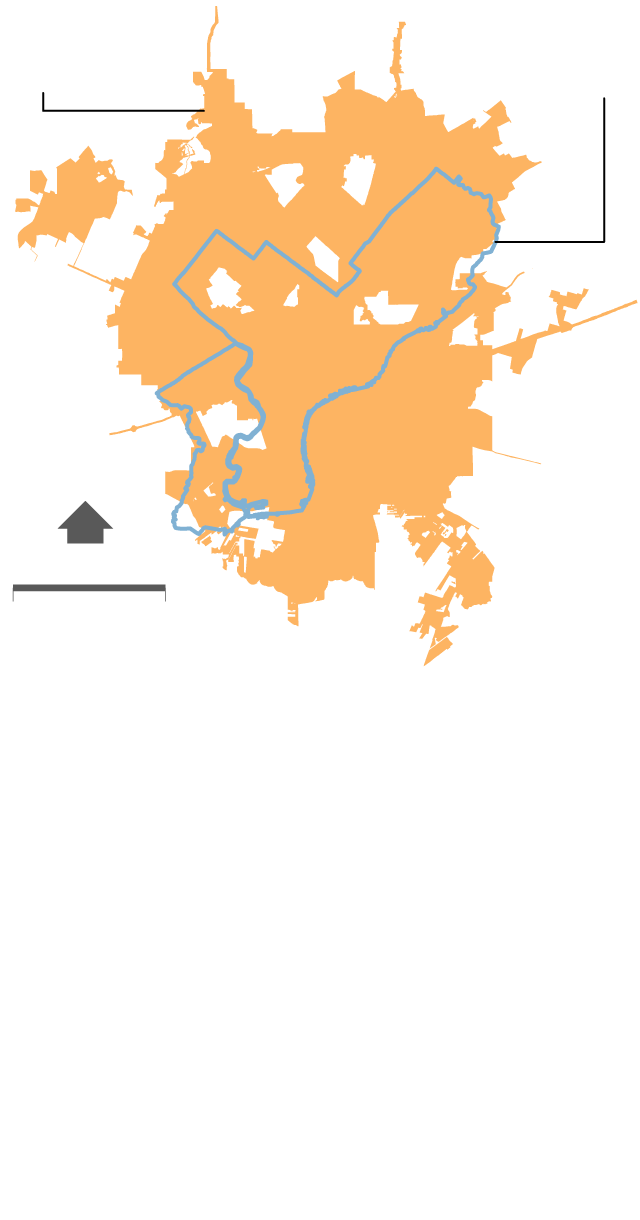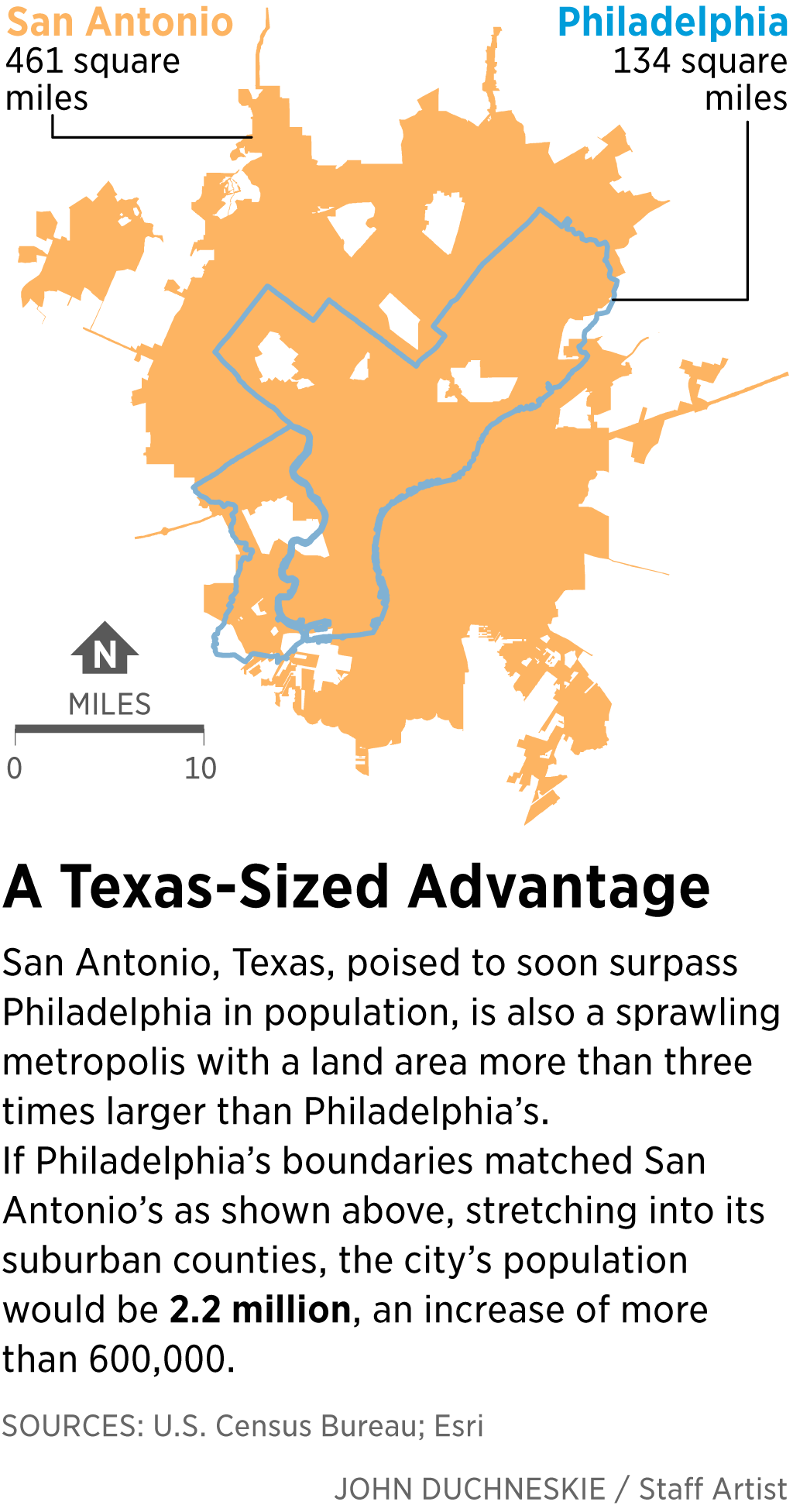Census population update: South Jersey slips; Pa. gains, but San Antonio about to pass Philly
Communities in South Jersey keep losing residents, while the Pennsylvania collar counties around Philadelphia keep gaining them, according to municipal population numbers the Census Bureau released Thursday.
/arc-anglerfish-arc2-prod-pmn.s3.amazonaws.com/public/OT6CTWHEN5BSTHEQRTKO5I6HAI.jpg)
South Jersey towns keep losing residents, while Philadelphia’s collar counties keep gaining them, according to municipal population numbers released Thursday by the Census Bureau.
Philadelphia, meanwhile, added more than 3,900 residents between 2017 and 2018 and 55,800 over the last eight years. But if growth trends over the last two decades continue, in two years the City of Brotherly Love will lose its spot as the country’s sixth-largest city. San Antonio will take its place.
Of the 101 municipalities in Burlington, Camden, and Gloucester Counties, more than three-quarters lost residents between 2010 and 2018. Of the 238 municipalities in Bucks, Chester, Delaware, and Montgomery Counties, three-quarters maintained or grew their populations during the same period.
Growth in the Pennsylvania suburbs
Between 2010 and 2018, Upper Providence Township, Montgomery County, gained about 3,000 residents, the largest bump in people in the region outside of Philadelphia.
The township’s growth really got started a couple of decades ago, after the construction of Route 422 and other state highways. Before those roads, the township was rural, said Timothy Tieperman, township manager.
Upper Providence added about 100 people between 1980 and 1990. Over the following decade, the township grew by 5,900, and added an additional 5,600 during the first decade of the century.
Several apartment complexes in the works could add 1,000 people in the next couple of years to the township of just under 25,000, said Tieperman, who estimates the township is 90 percent developed.
“We don’t react to development,” he said. "We try to direct it.”
Upper Providence is one of 17 municipalities in the region that grew by at least 10 percent between 2010 and 2018. All of those jurisdictions were in Pennsylvania except one — Woolwich Township, Gloucester County, which grew by 24 percent.
More people leaving South Jersey towns
Since 2010, 40 of the 46 municipalities in the Philadelphia region that lost at least 2 percent of their residents are in South Jersey. Twenty of those are in Burlington County.
But the town with the steepest percentage drop in residents is in Bucks County: Penndel Borough, population 2,159, lost nearly 7 percent of its residents between 2010 and 2018 — about 160 people.
Population losses in the city of Camden accounted for about half of the 6,000 residents Camden County has lost since 2010.
“Losing population is never ideal,” acknowledged Dan Keashen, Camden County’s spokesperson, but he said the county is well-positioned for a growth spurt.
“For the next 10 years the county is poised to see some of its largest growth in a generation with a number of large-scale residential development projects taking place in towns like Cherry Hill, Pennsauken, Voorhees, Winslow and more than 1,000 units being built and refurbished in Camden City,” he said in a statement.
Philadelphia vs. San Antonio
Since 2010, both Philadelphia and San Antonio have steadily gained residents. But the Texas city has been growing faster. Two decades ago, Philadelphia had about 195,000 more residents than San Antonio. Next year, the difference is projected to narrow to fewer than 12,000 residents.
The Texas city will surpass Philadelphia in 2021. In five years, San Antonio will have nearly 74,000 more residents than Philadelphia.
Five years ago, officials in San Antonio recognized it would be welcoming more people “at a pretty decent rate,” said Rudy Niño Jr., assistant director of San Antonio’s planning department. He said the city focuses growth in regional job centers to create higher-density areas that can be connected through public transportation.
“From our perspective, the idea is that if growth is going to occur, we want it to occur in a planned fashion,” Niño said.
But Philadelphia fits a lot more people into a smaller space. At 134 square miles, Philadelphia has 11,380 residents per square mile. San Antonio, on the other hand, is 461 square miles. Nearly 2,900 Texans live in each square mile. Superimpose San Antonio’s borders on the Philadelphia region, and the population would grow to 2.2 million.

A Texas-Sized Advantage
San Antonio
Philadelphia
461 square
miles
134 square
miles
San Antonio, Texas, poised to soon surpass Philadelphia in population, is also a sprawling metropolis with a land area more than three times larger than Philadelphia’s.
If Philadelphia’s boundaries matched San Antonio’s as shown at right, stretching into its suburban counties, the city’s population would be 2.2 million, an increase of more than 600,000.
N
SOURCES: U.S. Census Bureau; Esri
MILES
JOHN DUCHNESKIE / Staff Artist
0
10

San Antonio
Philadelphia
461 square
miles
134 square
miles
N
MILES
0
10
A Texas-Sized Advantage
San Antonio, Texas, poised to soon surpass Philadelphia in population, is also a sprawling metropolis with a land area more than three times larger than Philadelphia’s.
If Philadelphia’s boundaries matched San Antonio’s as shown above, stretching into its suburban counties, the city’s population would be 2.2 million, an increase of more than 600,000.
SOURCES: U.S. Census Bureau; Esri
JOHN DUCHNESKIE / Staff Artist

As for the prospect of eclipsing Philadelphia in population in a couple of years, Niño said it’s not something that planning officials would crow about.
“Whether there’s a level of prestige tied to a population statistic, I’m not quite sure that is something that we’re looking at, or focused on,” he said. “We haven’t said at all our goal is to be XYZ. We just want to be the best San Antonio that we can be.”